
off
Cima XII
“But it was always Cima XII, the highest of all peaks, which I thought to climb when I was a boy (…)
It was 1936 and I was not 15 years old yet; we left home the two of us at three in the morning, and it was dawn when we arrived at the bivouac of the shepherds at Bivio Italia. From there, without taking the long way round through the Cuvolini mule track, we took the path of the Caneve and we climbed straight through the defile that faces south. Great was our excitement when we came to see the abyss over the Val Sugana and the circle of the Alps from Cevedale to the Pale di San Martino, but even more mountains besides these, and then to the south our stony plateau with the very clear signs of great battles not yet covered by the mountain pines, and trunks of dead larches. It was a world beyond our horizon: this is what we saw from up there.”
From “Dentro la memoria” (Inside memory), edited by Giuseppe Mendicino, Meridiani Montagna: “Sul calesse di mio padre” (On my father’s gig).
“At the end of autumn, my autumn too, with my seven-year-old grandson I wanted to climb Cima delle Dodici once again. The day was clear and chilly, and in the shadowy sides of the mountain sheets of frozen snow still remained (…) The sunny sides instead were free, yellowish for dried grass and gray for washed rocks (…) In ancient times and until the nineteenth century, for us of the Plateau this mountain, the highest, was dedicated to Freya, wife of Odin and goddess of fertility, birth and death, the one who “enjoyed the love poetry”; and it was called Freyjoch, that is mountain, yoke of Freya.”
From “Amore di confine” (Border love,) “Sfida a Cima XII” (Challenge to Cima XII)
The context
The first passage is taken from the introduction to the book by G. Balzani and F. Gioppi, “Alpi di mezzogiorno. Storie di uomini e confini tra Valsugana e Altipiano” (Southern Alps. Stories of men and boundaries between Valsugana and the Plateau, Euroedit, Trento, 2001). It tells about the first approaches of a young Mario to the mountains, recalling the vitalist and adventurous spirit that had animated his entire adolescence.
Instead, in the second passage, in September 1984, the writer is 63 years old, and with good-natured irony he outlines an event of the early 20th century, when around the highest peak of the Plateau a picturesque conflict developed between the Italian irredentists and the Austrians, who garrisoned the Trentino’s mountainside at that time. The raids of the Italians, who hoisted the tricolour flag and painted white and red and green the cross of the peak, were repaired by the remedial actions of the others, dressed with blessings of their priests and ridiculous bureaucratic relations of border officials.
The story reveals what the attitude of Rigoni Stern was toward these border quarrels; it is that of shepherds, hunters and smugglers, who “did not care and (…) continued their activities as they had always done. That mountain remained Freyjoch or Cima delle Dodici, and the old and the new existed together (…)” But then the Great War came, “and from every part of Savoy Italy and of the Habsburg Empire tens of thousands men came here to die. Still today broken bones crop up.”
The route
The highest peak of the Plateau (also indicated on maps as Cima Ferrozzo, Italianisation of Freyjoch) can be reached from Bivio Italia (see the Galmarara itinerary, as done by Rigoni Stern in his first climb), or from Monte Forno, where you can arrive by car following the road, sometimes uneven, from Gallio to Campomulo, Malga Fiara, Piazza delle Saline, bivio (crossway) Monte Forno. The area is rich in war testimonies; before the Bivio del Forno it is worth pointing out the funny plaque that commemorates the truce between the Alpini of the Bassano Battalion and the Austrian soldiers in the winter 1916-1917, and the karst features.
Starting from the car park below Monte Forno (1,827 m), turn left on the military road that gently climbs up to the Bivio Conrad (1,937 m). From here, leaving the cartroad just before the crossroads, take the path on the right that quickly leads into the Kaiser Karl Strasse (Itinerary 835) that comes from Bivio Italia. Then continue heading north and leave the road to the trail along the curve to the right at altitude 1985, under Monte Frate. The slope rears up as you get closer to the peak, to which you arrive through the path 208 and from here the most steep part begins, that winds between rocks and mountain pines until you reach the wooden cross (2,236 m), after about two hours and a half of walking. To the north stands the second cross, the metallic one mentioned by Rigoni Stern in his story, placed by the SAT (Trentine Alpinists Society) of Borgo Valsugana. From the top the view is impressive, ranging from the Valsugana to Lagorai, the Dolomites to the north and the plains and sea to the south. All around you can distinguish all the peaks which were the battlefield of the toughest fightings of the Great War: Ortigara, Forno, Chiesa, where many military artefacts were recovered and an exhaustive set of signs and markings was placed.
For the descent you can take the path 211 from the metal cross to the bivouac of Buse delle Dodese (2,158 m.), and then go down southwards (unmarked path) until you reach the Kaiser Karl Strasse. Go up along it to a hundred metres just below the Baito del Cuvolin and the fountain with the same name (2,021 m). From here go eastward to join the itinerary 839, then go down for about 2.5 km and finally turn right to Malga Pozze and the car park.




